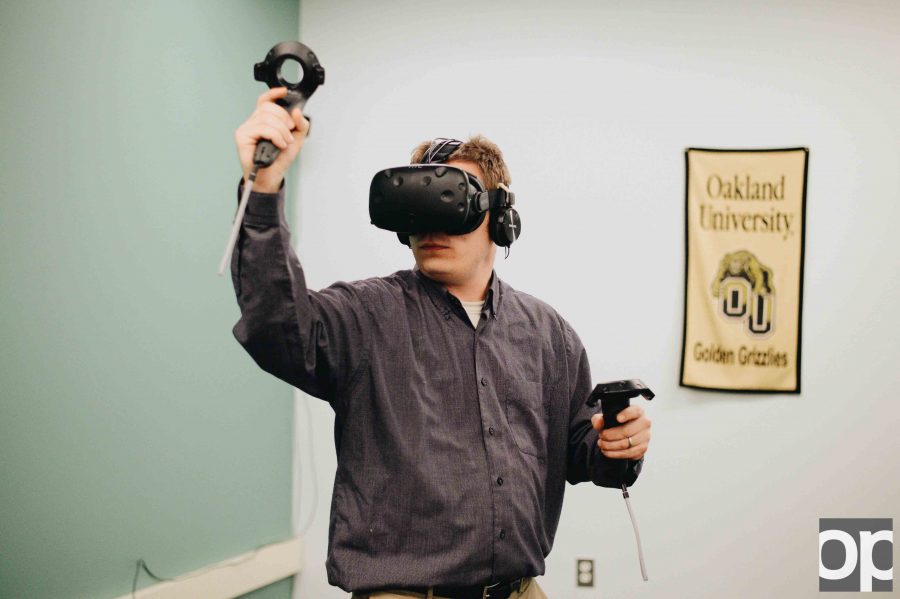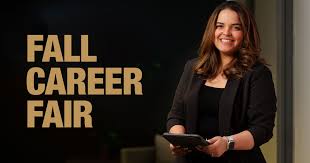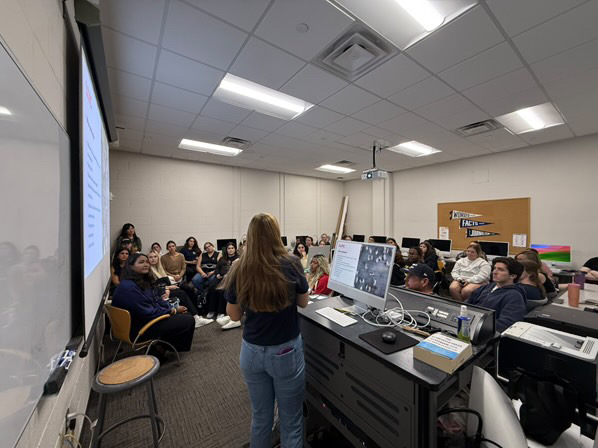e-LIS hopes virtual reality will add new dimension to learning
Matt Switlik tests out the new virtual reality program.
Imagine stepping into an elevator and feeling it ascend higher and higher. When it stops, the doors open up to the top of a skyscraper overlooking New York City. A two-by-four plank is hanging off the side of the building, far above the streets below, and on the very edge of it is a small kitten waiting to be rescued.
For most people, this experience is rather unobtainable. However, the opportunity to feel as though one has lived through experiences like this is becoming vastly more accessible.
After purchasing Vive, a $799 virtual reality simulator, Oakland University’s Department of e-Learning and Instructional Support held an open house for its virtual reality lab in fall 2016.
The lab consists of a 4-meter-by-3-meter space with cameras on the walls that paint the room with infrared, as well as computer monitors outside of the space that allow others to see what the player is seeing.
Users wear a headset and hold two controllers to enter the world of their choice.
A small camera at the front of the headset gives the player the option of seeing the real world as well. If the player wishes to be fully immersed without seeing the real world, a safeguard is built in. If the player gets too close to a wall, a virtual net will appear in the visual field as a warning.
Although they must be purchased separately, Vive offers a variety of games and simulations.
From experiencing an underwater whale encounter to defending a castle through archery to warding off zombies, the simulator provides games of make-believe likely past one’s wildest expectations.
Vive also offers many educational options, which are what e-LIS plans to pursue as early as the next month.
Simulation scenarios can be alternatives to academic practices, such as medical students’ use of cadavers.
“ . . . We get an anatomy app where we can go in there and pay for it once, [medical students] can use it anytime,” e-LIS Director Shaun Moore said, “They can use it as much as they want. It can be as realistic, just about.”
Foreign-language students could use Vive as a way to communicate with counterparts across the world who are learning English.
There are also options for communication majors, such as a simulation called “Keep Talking and Nobody Explodes.” In this scenario, one player puts on the headset and enters virtual reality, while the other participants sit near him or her.
The player in the game experiences a live bomb and must explain what he or she is seeing well enough that the other participants can flip through a book on disarming bombs and talk the player through it.
Students taking public speaking classes could also have the ability to enter a virtual reality scenario that puts them in front of a large crowd of people.
Simulations like Tilt Brush could allow art majors to draw in 3-D, and other programs could let engineering or architecture students build virtual structures.
Those pursuing a psychology degree could study their classmates’ reactions to living out their phobias, such as spiders or Richie’s Plank Experience, the scenario previously described.
“That is something I’ve noticed with VR, is it immerses people so much that they actually have really authentic emotional reactions to things,” said Matt Switlik, learning management programmer for e-LIS, who Moore described as “the resident VR expert.”
Although there may be some concerns about virtual reality’s side effects, according to Switlik, it normally should not cause nausea. However, if individuals spend an hour or two in a simulation, it may confuse their depth perception in the real world.
Moore reported that there is a possibility of a much larger lab with multiple Vive setups in the future if the need arises.
e-LIS invites any staff or professors interested in collaboration to email Shaun Moore at [email protected].









David Jones • Jan 25, 2018 at 10:40 AM
Trends are changing and at the same time, augmented and virtual reality is gaining huge popularity. A special place is occupied by training with the help of augmented and virtual reality. Augmented reality toys and games is future not only in education, but also in other spheres. More detailed and useful information, you can find in this blog : https://invisible.toys/news/
Jennifer • Mar 1, 2017 at 10:55 AM
Virtual reality nowdays is already really popular. Just the biggest problem is the cost. What makes difficult to use VR&AR at schools or in medicine in the whole world.
But like most forms of technology, the price starts to come down which is usually due to affordable components and products becoming smaller and more accessible. As more of them become available this also drives down the price which places them within the reach of many more people than before.
So I think in few years, this all will looks much more simple.
If you are interesting in Virtual&Augmented realities, here is one good blog https://thinkmobiles.com/blog/